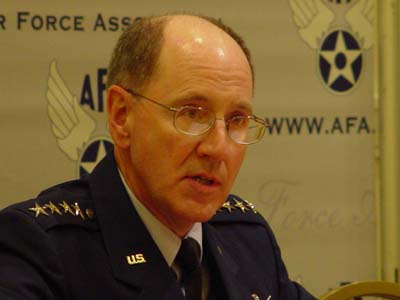 Air Force Space Command officials often speak at length about on-orbit systems and capabilities, but the head of the command would like you to remember that military space exists for one reason only: to support the needs of combat forces. This is true even in undeveloped locations such as Afghanistan, said Gen. Robert Kehler, AFSPC commander. “Everything we do for the warfighter applies to irregular warfare” and the war in Afghanistan, he noted Sept. 14 at AFA’s Air & Space Conference. He cited two specific examples of space support to US Central Command. First is increasing the bandwidth available to combat forces: “The second [Wideband Global Satellite communications system] is up there for CENTCOM,” he said. Second is GPS—Afghanistan’s rugged, remote terrain creates some “coverage issues,” he said, and Space Command planners are constantly working to optimize GPS access. There are currently 30 GPS birds in service, compared to a minimum requirement of 24, and “every time we put another” satellite on-orbit, planners reconfigure the constellation to maximize its effect.
Air Force Space Command officials often speak at length about on-orbit systems and capabilities, but the head of the command would like you to remember that military space exists for one reason only: to support the needs of combat forces. This is true even in undeveloped locations such as Afghanistan, said Gen. Robert Kehler, AFSPC commander. “Everything we do for the warfighter applies to irregular warfare” and the war in Afghanistan, he noted Sept. 14 at AFA’s Air & Space Conference. He cited two specific examples of space support to US Central Command. First is increasing the bandwidth available to combat forces: “The second [Wideband Global Satellite communications system] is up there for CENTCOM,” he said. Second is GPS—Afghanistan’s rugged, remote terrain creates some “coverage issues,” he said, and Space Command planners are constantly working to optimize GPS access. There are currently 30 GPS birds in service, compared to a minimum requirement of 24, and “every time we put another” satellite on-orbit, planners reconfigure the constellation to maximize its effect.
The final version of the fiscal 2026 defense policy bill calls for adding $1.2 billion to the Space Force’s research and development accounts, an increase that’s mostly split between two efforts: expanding the service’s low-Earth orbit data transport network and boosting its space-based missile warning and tracking capabilities.

